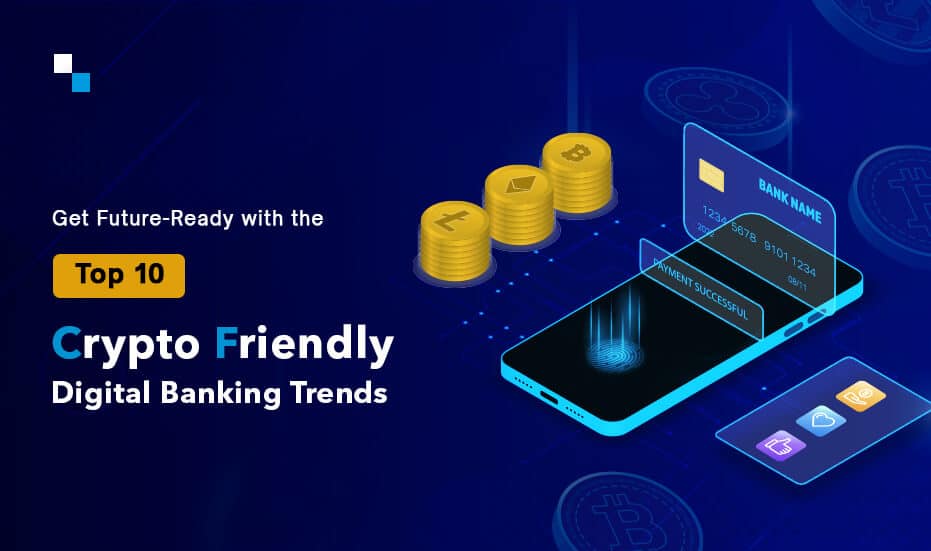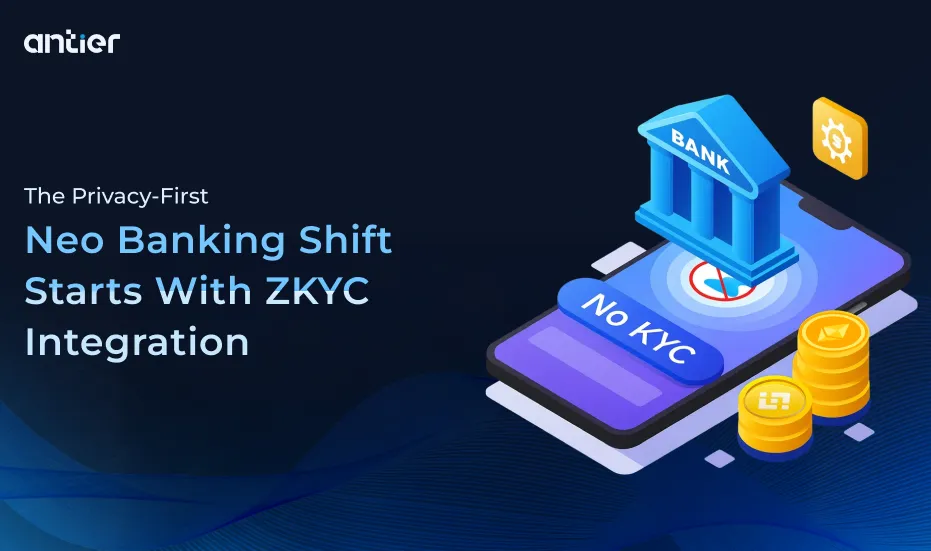With a move toward digitalization, the incredibly quick growth of technology is drastically changing the concept of banking. With its greater simplicity, effectiveness, and security for clients, this digital innovation is increasingly establishing itself as the norm.
The newest developments are reshaping banking and changing how we interact with our finances, from the rise of AI and machine intelligence to the rising popularity of mobile banking. It can be difficult to stay up with the most recent trends and innovations in the industry with so many improvements occurring so quickly. This article will shed light on the latest top 10 trends that will encourage you to pick crypto friendly digital banking solution for futuristic services.
Let’s get started!
Top 10 Banking Trends to Watch Out for 2023
- Trend 1 : Digital channels
Visiting a bank and waiting in line to speak with a representative or a customer service agent could soon become a thing of the past. With the development of digital banking solutions and white label digital bank solutions, customers can anticipate quick and simple services. Customers want banking to be highly digitalized in the same way as other businesses.
Financial institutions must also be aware that a sizeable section of their clientele may decide to do business with a rival who provides the convenience of digital channels. This is true even if other components of that competitor’s history, reputation, or range of offerings are lacking. There may not even be physical banks in the future, given the direction that online banking is taking. Thus, it is fruitful to get your digital banking platform developed.
- Trend 2 : Artificial intelligence (AI)
The banking sector is being rapidly transformed by artificial intelligence (AI). AI is being used by banks to enhance customer service, spot fraud, and automate repetitive jobs. In the banking sector, AI-powered chatbots are gaining popularity because they give users a quick and simple way to get answers to their inquiries.
AI is also being utilized to enhance credit scoring and risk management. Banks are analyzing client data and precisely predicting their creditworthiness using machine learning algorithms. Faster loan approvals and improved risk management follow from this.
Additionally, banking experiences are becoming personalized with AI. The demands and preferences of the consumer might be taken into account when banks offer customized recommendations and products. This raises income for banks while also enhancing consumer satisfaction.
- Trend 3 : Chatbots and Virtual Assistants
Virtual assistants and chatbots are very likely to have appeared on applications and websites by now. They are widely used, and as more powerful and sophisticated artificial intelligence (AI) technology is developed, their quality and accuracy continue to rise. The pace of customer assistance increases along with this technology’s development.
With just a few prompts, chatbots and virtual assistants may now direct customers. Nowadays, it is typical to witness issues being resolved without the need for a customer to speak with a real person representative. It is time to learn how to build a digital crypto bank while implementing and giving priority to current advancements in AI technology, if you want to be the global leader.
- Trend 4 : Blockchain technology
Although it is relatively a new idea, blockchain technology is already changing the banking sector. It specifically is being investigated by banks to enhance security, lower costs, and expedite procedures.
As known, blockchain technology makes cross-border transactions an appealing choice because it provides a transparent and safe method of money transfer. Moreover, fraud can be decreased, with improved identity verification options available. Even the possibility of issuing digital currencies or central bank digital currencies (CBDCs) using blockchain technology is being worked on by some institutions. With faster, less expensive, and more secure transactions, CBDCs have the potential to revolutionize how we use and store money.
- Trend 5 : Personalized Banking Experience
Personalization is a significant trend in online banking that has a great impact on how banks communicate with their consumers. Banks can provide specialized suggestions, individualized product offerings, and specialized marketing campaigns by utilizing consumer data and preferences. In turn, this strategy aids in fostering strong customer relationships, retention, and customer experience and gives businesses a competitive edge in a market that is changing quickly. Higher customer involvement results in higher use of banking services, which can boost income for the bank.
In the upcoming years, personalization is anticipated to be a crucial component of white label digital banking solutions. With the growing availability of customer data and sophisticated analytics technologies, banks will provide their clients with highly customized services. Offering specialized credit products, individualized investment portfolios, and personalized financial guidance are a few examples of this.

- Trend 6 : Open Banking APIs
As the name suggests, Open Banking API refers to the practice of banks allowing third-party providers access to their Application Programming Interface (API). Financial technology businesses are frequently these third parties. They might provide services such as tax preparation, debt management, insurance sales, BNPL (Buy Now, Pay Later), and apps or software for online payments.
Banks hand up their customers’ information to third-party companies. It is very obvious that this is a significant and logical step in the direction of total digital transformation. Banks must ensure the security of their customers’ data by putting in place robust security protocols and only sharing information with consent in order to accomplish this.
- Trend 7 : No-code/Low-code Development Platforms
With no-code/low-code development platforms enabling banks to create digital goods rapidly and effectively, the banking sector is observing a trend toward shorter time to market.
It is anticipated that no-code and low-code development platforms will be widely used in banking by 2023 for a number of reasons-
(1) Banks will need to drastically shorten the time it takes them to launch digital products and services
(2) An increase in the number of independent fintech companies providing ready-made digital solutions that can be quickly connected with basic banking systems
(3) A lack of qualified workers with application development expertise.
- Trend 8 : Self-Service Tools for Customers
Customers are increasingly looking for self-service solutions in the banking industry. Banking consumers are making it obvious that they want to accomplish things on their own, contrary to what the prevailing reasoning might have you believe. This presents an intriguing challenge to banks worldwide.
A successful digital transformation should give clients the tools and technology they need to feel confident and independent while using their financial services. Banks must create the appropriate self-service tools and strike a balance between providing personalized customer support and ensuring that customers do not feel confined while using crypto banking platform development.
- Trend 9 : Metaverse’s Extension
Virtual reality (VR) and augmented reality (AR) are two technologies that are used to create a network of connected, digitally upgraded environments called the metaverse. The arrival of this brand-new virtual reality universe is imminent.
A new virtual environment with cutting-edge interaction, entertainment, and employment opportunities will be created as the metaverse develops. There will undoubtedly be a desire for financial transactions there as well as in the actual world, but from the users’ perspective, there should be no territorial, temporal, or spatial restrictions.
- Trend 10 : Biometric Authentication
Biometric authentication is becoming an increasingly common method to secure banking transactions as cybersecurity threats continue to advance. To confirm a customer’s identification, biometric authentication uses distinctive physical traits like fingerprints, facial recognition, and iris scans. Since users do not need to carry security tokens or remember complicated passwords, it is not only more convenient but also safer than conventional password-based authentication solutions.
Further, by identifying and thwarting unwanted access attempts, it can aid in preventing financial fraud. As a part of crypto friendly digital banking solution, we may anticipate seeing biometric authentication become increasingly commonplace and integrated into mobile banking and digital wallets.
Conclusion
New ideas and technology are always emerging in the banking sector, which is changing quickly. With more convenience, effectiveness, and security for customers, crypto friendly digital banking is swiftly taking over the industry. These innovations, which range from blockchain technology to AI and mobile banking, are reshaping the banking industry and changing how we manage our money.
Staying current with white label digital banking solutions is crucial if you want to remain relevant and competitive in the rapidly changing world of digital banking. If you are a bank that wants to invest in these trends and technology to draw in new clients, keep existing ones, and boost sales, connect with the domain experts of Antier. We can assist you with the best to thrive in the future of banking, whether you’re a consumer, a banker, or a budding businessman.
Don’t waste time, get in touch now and get started!







